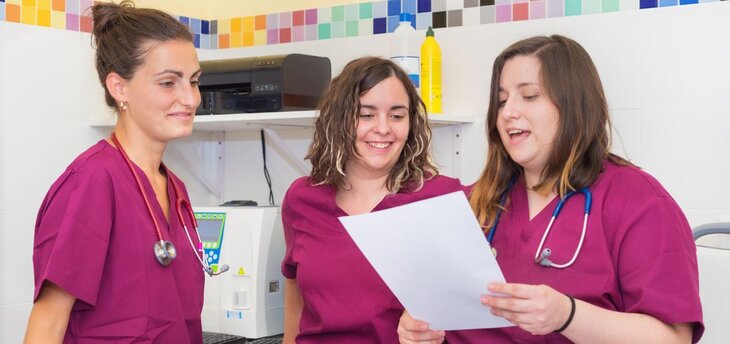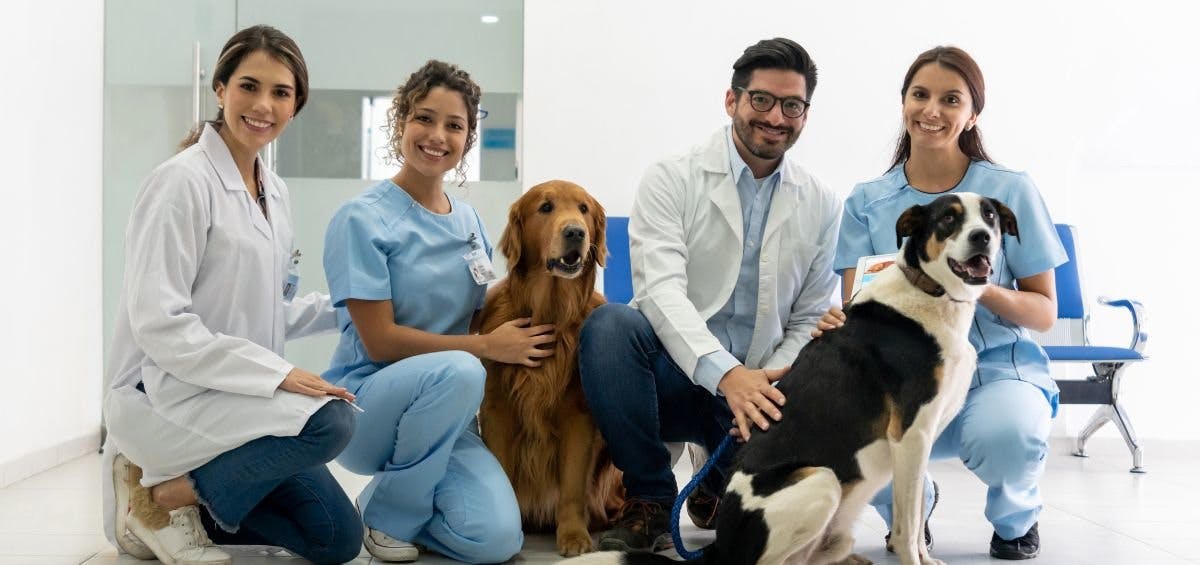5 Vet Clinic Team-Building Ideas to Try in 2024
As the veterinary community braces for the impending challenges of a predicted staffing shortage, cultivating a resilient and satisfied workforce is crucial now more than ever. The MARS Veterinary Health study underscores the urgency of this issue by forewarning the need for an additional 55,000 veterinarians by 2030.1 Amidst this backdrop, the importance of team building within veterinary clinics cannot be overstated.
Team-building activities foster a sense of camaraderie and mutual respect among staff members and play a pivotal role in combating employee burnout by enhancing workplace satisfaction. As we usher in 2024, we present five impactful team-building ideas that vet clinics should consider implementing in the coming year. These strategies could alleviate staffing concerns by improving employee morale and ultimately contribute to better service for our beloved companion animals.
The Importance of Veterinary Team-Building and Practice Culture
The term "team building" may conjure up images of clichéd activities like trust falls and ropes courses, but these exercises can yield tangible benefits for your team and the patients you serve. Team building activities for vet teams can deepen trust, enhance communication, strengthen employee commitment, and aid in conflict resolution.
Though conflicts can arise from various sources, their negative impact on productivity and service quality is consistent no matter the root cause. Team-building initiatives can mitigate these frictions, benefiting management, clients, patients, and staff with better experiences all around. In fact, one recent study found that highly engaged teams show 21% greater profitability, and the most successful organizations are those that prioritize employee engagement within their business strategy. 2
21% greater profitability
shown in highly engaged teams
Team building also contributes to an enriched work culture, shaping how team members interact and perceive their roles, resulting in a productive environment where employees feel valued and involved in making a difference.
Engaged employees are more loyal, lowering the cost of turnover and its impact on your bottom line. By building up your veterinary team and cultivating a positive work culture, your practice can attract and retain top talent more easily.
Vet Clinic Team-Building Ideas
Below are five team-building ideas for vet clinics that you can implement to improve your practice in 2024 by creating a positive work culture that improves employee retention and an engaged workforce that delivers better patient care.
1. Provide opportunities for your staff to learn and develop new skills.
Studies have shown that career development significantly impacts employee satisfaction — with most respondents believing it to be important (44%) or very important (39%) — so creating opportunities for your staff to develop their skills is crucial.3,4 However, vet professionals often lead hectic lives, so career development must be structured in an accessible and manageable way.
One effective method is to embed education into the typical workflow by scheduling a veterinary Lunch-and-Learn (LnL) on a monthly or weekly basis. LnLs are concise yet informative seminars hosted by third-party businesses within the veterinary industry. They usually occur during lunch, so you can seamlessly integrate team-building in the vet practice without needing extended time commitments or out-of-office participation.
LnLs offer staff the chance to broaden their knowledge, keep up with vet industry trends , engage in discussions, devise success strategies, and exhibit leadership. Some companies even provide Continuing Education (CE) credits for LnL attendance. Vets require CE credits to maintain ongoing certification in the field, and your team will undoubtedly appreciate the convenience of earning these credits without additional financial burden.
Schedule a Lunch-and-Learn with Pawlicy Advisor
Get a free catered lunch for your team while learning why the American Animal Hospital Association recommends Pawlicy Advisor's streamlined practice solution.
Many LnLs also come with the added perk of catered lunches. This not only saves your team on food costs but is also a thoughtful gesture, considering the average veterinary graduate grapples with a substantial amount of student loan debt. After the presentation, initiate a conversation about how the team could implement the knowledge they've gained into your practice. Acknowledge their efforts by providing verbal or written recognition whenever you observe these new skills being put into action.
Pro Tip: it's important to remember that if LnLs are held during the typical lunch break, it's only fair to offer brief breaks throughout the day to allow team members to have some personal time, decompress, and handle any personal matters outside of work. A balanced approach like this ensures your team feels valued and supported both professionally and personally.
2. Send staff to a veterinary conference.
There are many benefits to sending staff members to a vet conference beyond strengthening the team at home. First, continuing education is critical to guaranteeing that your clinic remains at the forefront of advancements in veterinary medicine. It also allows employees who may feel drained by the prevalent challenges they face on the job — from stressful financial conversations with vet clients to aggressive dogs in the exam room — to get outside the hospital, listen to professional experts, and learn about new industry trends.

Attendees can sit in on various lectures that discuss topics such as the pet insurance marketplace, practice management tips, latest AAHA guidelines, and alternative therapies like acupuncture for dogs . As the field of veterinary medicine constantly evolves with new research, techniques, trends, and technologies, CE ensures that veterinary professionals maintain the most up-to-date knowledge and skills to provide the highest level of care to animals.
Depending on the veterinary conference and its location, it might cost you anywhere between a couple hundred and a couple of thousand dollars to send a few employee ambassadors, but 94% of employees say they’d stay with a company longer if it invested in their career .4 Conference attendance promotes continuous learning whiling giving the participants leadership opportunities by sharing what they’ve learned with the rest of the veterinary practice.
94% of employees
would stay with a company longer if it invested in their career
3. Start every day with a morning huddle.
A daily standup meeting or team huddle five to 10 minutes before the business opens can have a tremendous impact on the entire vet office. This is a good time to review key details, such as:
- Team members out for the day
- Roles that need to be covered, swapped, or filled
- Hospitalized patients and their medical needs
- Possible bottlenecks from a client service standpoint
- Major veterinary resources or veterinary news worth sharing
Once the doors open for business, it can quickly become chaotic as the lobby begins to fill with patients and communication in the vet office often turns into a game of telephone. Morning huddles ensure alignment within the practice while helping team members connect on a more personal level, fostering empathy, and reinforcing the passion everyone shares for animals.

4. Participate in community outreach initiatives.
Have a discussion with your team about what’s going on in the community and what they are passionate about. Agree on one or two passions shared by everyone on your team and look for a local, relevant volunteer opportunity or create your own project. Some ideas might include:
- A pet food drive for a local shelter
- Helping the homeless with their pet needs
- A beach clean-up removing trash and toxins hazardous to pets
- A gently-used toy drive for rescue organizations
- Transporting pets to no-kill shelters
Many of these ideas can take place in your vet clinic without posing a conflict to business operations; you can even encourage your clients to participate to maximize the impact on your community while bolstering your brand perception.
If possible, consider closing early one afternoon and leaving the hospital to volunteer for a local organization to strengthen a sense of comradery.. Getting out of the hospital setting can allow new dynamics to emerge, especially if your volunteer project relies on a different skillset than veterinary medicine.
Working together towards a common good strengthens team unity and promotes the clinic's positive image in the community. Plus, giving back often boosts morale and provides a sense of purpose beyond the day-to-day operations of the hospital.
Adam Thompson, DVM
5. Create a gratitude box.
In our veterinary hospital, one unique idea we’ve implemented to pull the team together is our "gratitude box." This is essentially the inverse of a traditional complaint box. It could be a custom-made box or something as uncomplicated as a repurposed tissue box.
The purpose of this box is for team members to deposit notes of encouragement, praise, or recognition, which are then read out loud on a weekly basis. These notes could commend a colleague for a job well executed, or recount an instance where the team successfully navigated through a challenging situation.
It's crucial to acknowledge that team member dissatisfaction often stems from feelings of under-appreciation by both leadership and peers. Given the rapid pace of the veterinary medicine field, consistently providing positive feedback can be a challenging task. However, the gratitude box serves as a practical solution to ensure regular appreciation, making your team members aware of how valuable they truly are.

Final Thoughts
In conclusion, it's essential to understand that team-building activities in the veterinary field extend far beyond mere leisurely distractions or simple bonding exercises. These activities play an absolutely critical role in fostering a spirit of collaboration within veterinary clinics, building trust amongst team members, and enhancing overall communication.
In the face of a projected decrease in the pool of applicants, these team-building activities also serve as valuable tools for attracting and retaining top-tier talent. The benefits of a strong, engaged, and cooperative team extend to the clients and patients, as well, because such teams are capable of delivering superior care to their patients.
Moreover, a team that works well together is invariably more efficient, leading to increased productivity and profitability in your business operations. Therefore, investing in team-building for your veterinary team today is not just a short-term strategy but a long-term asset. As you move forward into 2024 and beyond, the returns on this investment will keep amplifying, turning your veterinary clinic into a well-oiled, high-performing machine that provides exceptional care to its patients.
References
- Tackling the Veterinary Professional Shortage. Mars Veterinary Health. Published March 2, 2022. Accessed December 29, 2023. https://www.marsveterinary.com/tackling-the-veterinary-professional-shortage/
- Harter J. Employee Engagement vs. Employee Satisfaction and Organizational Culture. Gallup. Published April 12, 2017. Accessed December 29, 2023. https://www.gallup.com/workplace/236366/right-culture-not-employee-satisfaction.aspx
- Importance of career development opportunities to U.S. employee job satisfaction 2015. Statista. Published April 18, 2016. Accessed December 29, 2023. https://www.statista.com/statistics/226701/us-employees-career-development-importance/
- Developing Employees & Improving Performance. LinkedIn Learning. Accessed December 29, 2023. https://learning.linkedin.com/resources/career-development/develop-employees
Do you want to find the best pet insurance?
Let's analyze your pet's breed, age, and location to find the right coverage and the best savings. Ready?
Analyze My PetAbout Pawlicy Advisor
The pet insurance marketplace endorsed by veterinarians, at Pawlicy Advisor we make buying the best pet insurance easier. By comparing personalized coverage and pricing differences we can save you a ton of money, up to 83% in some instances!
Instantly Compare Pet Insurance Plans
Guides
Determine If Pet Insurance Is Worth It
Comparison Charts
Find Your State
Dog Insurance
DVM
Adam Thompson, DVM, is a small animal veterinarian at a private practice in north Alabama. He enjoys educating pet owners and providing them with the best care possible for their pets. He has a passionate interest in nutrition, dentistry, dermatology, and preventative medicine. Dr. Thompson is married to his wife (also a veterinarian), and they have two children. They also have a Boston Terrier mix named Newman.
